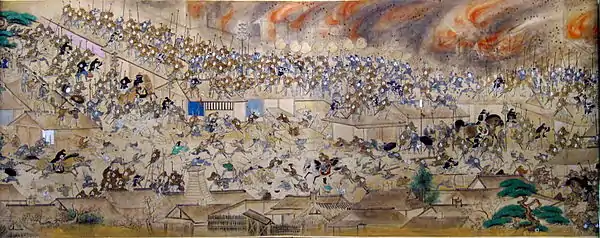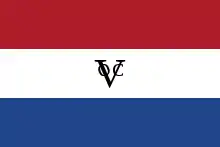Zacharias Wagenaer
Zacharias Wagenaer (also known as Wagener, Wagenaar and Wagner) (10 May 1614 – 12 October 1668) was a clerk, illustrator, merchant, member of the Court of Justice, opperhoofd of Deshima and the only German governor of the Dutch Cape Colony. In 35 years he traveled over four continents.
Zacharias Wagenaer | |
|---|---|
| 17th Opperhoofd at Dejima | |
| In office 1 November 1656 – 27 October 1657 | |
| Preceded by | Joan Bouchelion |
| Succeeded by | Joan Bouchelion |
| 19th Opperhoofd at Dejima | |
| In office 22 October 1658 – 4 November 1659 | |
| Preceded by | Joan Bouchelion |
| Succeeded by | Joan Bouchelion |
| 2nd Commander of the Cape | |
| In office 6 May 1662 – 27 September 1666 | |
| Preceded by | Jan van Riebeeck |
| Succeeded by | Cornelis van Quaelberg |
| Personal details | |
| Born | 10 May 1614 Dresdner Neustadt |
| Died | 12 October 1668 (aged 54) Amsterdam |
| Resting place | Oude Kerk, Amsterdam |
| Spouse(s) | Anna Auxbrebis |
Biography
Early life and career
Zacharias was the son of a Saxonian judge and a painter. In 1633 he traveled from Dresden via Hamburg to Amsterdam. There he worked for Willem Blaeu. Within a year he enlisted as a soldier in the armed forces of the Dutch West India Company to serve in "New Holland" (Dutch Brazil) in 1634. Three years later, he was hired as a writer by the newly arrived governor of the colony, Count John Maurice, Prince of Nassau-Siegen. In Recife he kept a sort of diary with 109 water-colour drawings of curious fish, strange birds, useful and harmful animals, lovely tasty fruit and nasty, poisonous worms and big, brown or black people, published as "Thier-Buch". There are pictures of the smooth hammerhead, cutlassfish, slender filefish, Serranidae, and Cirripedia. On 1 April 1641, he left Dutch Brazil, and arrived on Texel on 17 June. He traveled back to Dresden arriving 12 October.[1][2]:553[3]:497 After four months, he left Dresden to return to the Netherlands arriving at Amsterdam on 29 March 1642,[3]:497 and took a position with the Dutch East India Company (Dutch: Vereenigde Oostindische Compagnie, commonly abbreviated to VOC).
Dutch East Indies
On 29 September 1642 he sailed for the Indies as an apprentice officer (Dutch: adelborst).[1] In the next year he became an assistant for the governors Antonie van Diemen and Cornelis van der Lijn; in 1646 he became under-merchant and in 1651 merchant. Three times he became a member of the Court of Justice at Batavia. In 1653 he went on a mission to Canton to open up again trade relations, which proved fruitless, due to a civil war after the Fall of the Ming Dynasty.

In 1657 he rose to the rank of opperhoofd (senior official) of the VOC at the small island in Nagasaki bay in the Japanese island of Kyushu, Dejima. He traveled to the capital Edo in a tributary mission and escaped from a burning city, which started on 2 March 1657. (There is a drawing from his hand in the Edo-Tokyo Museum.) In 1659, as one of the first "opperhoofden", he ordered a dinner service, consisting of 200 pieces.[4]:164 Wagener made the design of this Japanese porcelain, according to the European taste white and blue, with many flowers.[5][6]:126–127
In 1660 Wagner was involved in the peace negotiations with the sultan of Makassar. The port had about 2000 Portuguese traders and for years threatened the Dutch spice trade on the Moluccas. The next year he was head of the Public Works in Batavia.
Dutch Cape Colony
In 1662 he went to Cape of Good Hope with his small family, five slaves and two horses.[4]:165 He followed Jan van Riebeeck as a governor on 6 May. Riebeeck left the next day. In December 1663 he asked Batavia to send him some pottery from Persia.[4]:167 He negotiated with the Hottentots about cattle for the Company.[7] By abstaining from further expeditions Wagener could pursue his policy to refrain from an interference in tribal disputes, and to keep strictly neutral. After five years studying, the German student Georg Friedrich Wreede wrote a compendium of the Dutch and Hottentot language.[8]:273–274[9] Wagener appointed him in Mauritius.
Wagener was one of the five people laying the foundation of the Castle of Good Hope, which was started in August 1665.[10] He constructed a waterbasin, supplying the ships with fresh water, a hospital, a school and a church. In 1666 his wife Anna Auxbrebis, whom he had married in 1648, died.
Later life
On 27 September 1666 he resigned and Wagener went back to Batavia with his stepdaughter. He sold his slaves from Bengal. With presents he went to see the susuhunan of Mataram, who refused to trade with the VOC. While his knowledge of the Malay or Javanese language wasn't very good, the mission turned out to be fruitless; Wagener visited Japara afterwards. The year after he sailed back to Amsterdam as a vice-admiral, and in ill health. He was buried on 16 October 1668 in the Old Church.
An excerpt of his diary was translated from the High Dutch into English and published in 1704 and 1732.[2][3][1] A manuscript with fundamentally the same excerpt—but in German—has been a part of the Collection of Prints, Drawings and Photographs (German: Kupferstich-Kabinett) of the Dresden State Art Collections since at least the beginning of the 18th century.[1][lower-alpha 1]
Terms as opperhoofd
Wagner served two terms as opperhoofd in alternation with Joan Boucheljon:
- Joan Bouchelion: 23 October 1655 – 1 November 1656
- Zacharias Wagenaer [Wagener]: 1 November 1656 – 27 October 1657
- Joan Bouchelion: 27 October 1657 – 23 October 1658
- Zacharias Wagenaer [Wagener]: 22 October 1658 – 4 November 1659
- Joan Bouchelion: 4 November 1659 – 26 October 1660
Work
- Wagenern, Zacharias (c. 1641). Thier Buch (in German). Unter hochlöblicher Regierung des hochgebornen Herren Johand Moritz Graffen von Nassau, Gubernator Capitain, und Admiral General – via Kupferstich-Kabinett.
Gallery
 Insects, Kupferstich-Kabinett (Dresden)
Insects, Kupferstich-Kabinett (Dresden) Caranguejo (crab)
Caranguejo (crab)
Notes
- The manuscript text is reproduced in [1].
References
- Michel, Wolfgang (July 1987). "Zacharias Wagner und Japan (I) – Ein Auszug aus dem Journal des 'Donnermanns'" [Zacharias Wagner and Japan (I) – The Autobiography of a 'Thunderman']. Dokufutsu Bungaku Kenkyû (in German). Fukoka: Kyushu University (37): 53–102. Archived (PDF) from the original on 23 November 2016.
- Churchill, Awnsham; Churchill, John (1704). "A Short Account of the Voyages of Mr. Zachary Wagener, Perform'd in 35 Years, Through Europe, Asia, Africa and America, Taken out of his own Journal.". A Collection of Voyages and Travels, Some now first Printed from Original Manuscripts. Others Translated out of Foreign Languages, and now first Publish'd in English. To which are added some few that have formerly appear'd in English, but do now for their Excellency And Scarceness deserve to be Re-printed. In Four Volumes. With a General Preface, giving an Account of the Progress of Navigation, from its first Beginning to the Perfection it is now in, &c. II. London. pp. 552–556. ISBN 0665140509. OCLC 1111839530. OL 23704084M. Retrieved 25 February 2020.
- Churchill, Awnsham; Churchill, John (1732). "A Short Account of the Voyages of Mr. Zachary Wagener, Perform'd in thirty five Years, Through Europe, Asia, Africa and America, Taken out of his own Journal". A Collection of Voyages and Travels, some Now first Printed from Original Manuscripts, others Now first Published in English. In Six Volumes. With a General Preface, giving an Account of the Progress of Navigation, from its first Beginning. II. pp. 496–500. ISBN 066533298X. OL 24344176M. Retrieved 23 February 2020.
- Schoeman, Karel (2006). Kinders van die Kompanjie (in Afrikaans). Pretoria: Protea Boekehuis. ISBN 1869191196.
- 伊万里焼 [imariyaki]. Japanese Architecture and Art Net Users System. 2001. Retrieved 31 January 2021.
- Volker, T. (1971) [1954]. Porcelain and the Dutch East India Company, as recorded in the Dagh-registers of Batavia Castle, those of Hirado and Deshima, and other contemporary papers, 1602–1682. Leiden: E. J. Brill. OCLC 600674148.
- Theal, George MacCall (1897). History of South Africa Under the Administration of the Dutch East India Company, 1652 to 1795 (2nd ed.). London: Swan Sonnenschein & Co. OCLC 25939696. Retrieved 24 February 2020.
- den Besten, Hans (2010). Huigen, Siegfried; de Jong, Jan L.; Kolfin, Elmer; et al. (eds.). "A badly harvested field: The growth of linguistic knowledge and the Dutch Cape colony until 1796" (PDF). The Dutch Trading Companies as Knowledge Networks. Intersections – Interdisciplinary Studies in Early Modern Culture. Leiden: Koninklijke Brill. 14: 267–294. doi:10.1163/ej.9789004186590.i-448. ISBN 9789004186590. S2CID 161385081. Retrieved 24 February 2020.
- Wreede, Georg Friedrich (1916). Godée-Molsbergen, Everhardus Cornelius (ed.). G.F. Wreede's Hottentotse Woordelijst. Reizen in Zuid-Afrika in de hollandse tijd. 1. 's-Gravenhage: Martinus Nijhoff. pp. 215–224.
- Spohr, Otto H; Wagner, Zacharias (1967). Zacharias Wagner, second commander of the Cape. Cape Town, Amsterdam: A.A. Balkema. OCLC 3424966.
Further reading
- van Anrooy, Francine; et al. (1987). Holland Village Museum (ed.). The Dutch East India Company in the 17th century: life and work of Zacharias Wagenaer (1614–1668). Nagasaki: Holland Village Museum.
- Michel, Wolfgang (1995). "Hans Juriaen Hancke, Zacharias Wagener und Mukai Genshō: Aspekte einer 'lehrreichen' Begegnung im 17. Jahrhundert" (PDF). Bulletin of the Graduate School of Social and Cultural Studies (in German). Kyushu University (1): 109–114. Archived from the original (PDF) on 23 November 2016.
- Pfaff, Sybille (1997). Zacharias Wagener (1614–1668) (Thesis) (in German). Haßfurt: Otto-Friedrich-Universität Bamberg (published 2001). OCLC 1069179252.
| Wikimedia Commons has media related to Zacharias Wagner. |


